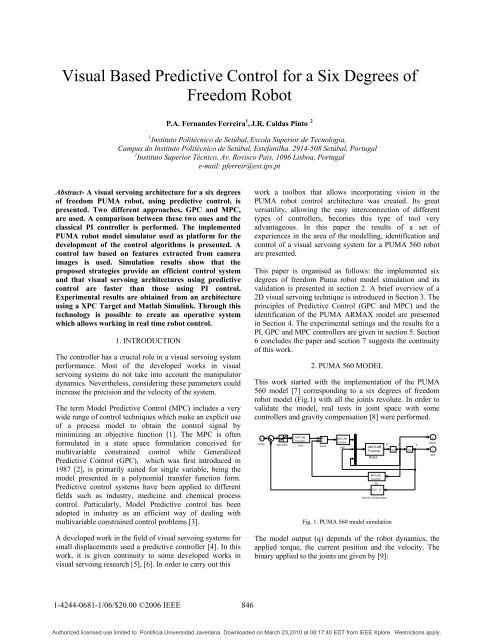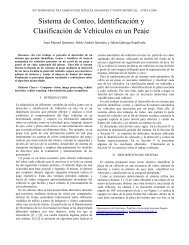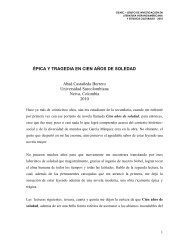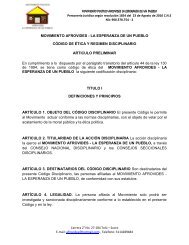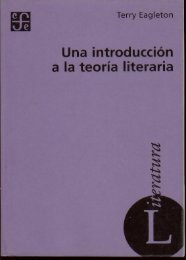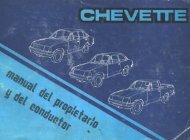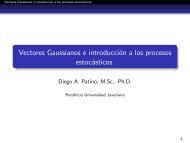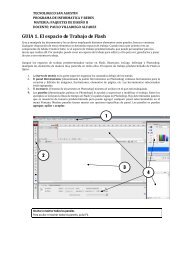Visual Based Predictive Control for a Six Degrees of Freedom Robot
Visual Based Predictive Control for a Six Degrees of Freedom Robot
Visual Based Predictive Control for a Six Degrees of Freedom Robot
You also want an ePaper? Increase the reach of your titles
YUMPU automatically turns print PDFs into web optimized ePapers that Google loves.
<strong>Visual</strong> <strong>Based</strong> <strong>Predictive</strong> <strong>Control</strong> <strong>for</strong> a <strong>Six</strong> <strong>Degrees</strong> <strong>of</strong><br />
<strong>Freedom</strong> <strong>Robot</strong><br />
P.A. Fernandes Ferreira 1 , J.R. Caldas Pinto 2<br />
1 Instituto Politécnico de Setúbal, Escola Superior de Tecnologia,<br />
Campus do Instituto Politécnico de Setúbal, Estefanilha. 2914-508 Setúbal, Portugal<br />
2 Instituto Superior Técnico, Av. Rovisco Pais, 1096 Lisboa, Portugal<br />
e-mail: pferreir@est.ips.pt<br />
Abstract- A visual servoing architecture <strong>for</strong> a six degrees<br />
<strong>of</strong> freedom PUMA robot, using predictive control, is<br />
presented. Two different approaches, GPC and MPC,<br />
are used. A comparison between these two ones and the<br />
classical PI controller is per<strong>for</strong>med. The implemented<br />
PUMA robot model simulator used as plat<strong>for</strong>m <strong>for</strong> the<br />
development <strong>of</strong> the control algorithms is presented. A<br />
control law based on features extracted from camera<br />
images is used. Simulation results show that the<br />
proposed strategies provide an efficient control system<br />
and that visual servoing architectures using predictive<br />
control are faster than those using PI control.<br />
Experimental results are obtained from an architecture<br />
using a XPC Target and Matlab Simulink. Through this<br />
technology is possible to create an operative system<br />
which allows working in real time robot control.<br />
1. INTRODUCTION<br />
The controller has a crucial role in a visual servoing system<br />
per<strong>for</strong>mance. Most <strong>of</strong> the developed works in visual<br />
servoing systems do not take into account the manipulator<br />
dynamics. Nevertheless, considering these parameters could<br />
increase the precision and the velocity <strong>of</strong> the system.<br />
The term Model <strong>Predictive</strong> <strong>Control</strong> (MPC) includes a very<br />
wide range <strong>of</strong> control techniques which make an explicit use<br />
<strong>of</strong> a process model to obtain the control signal by<br />
minimizing an objective function [1]. The MPC is <strong>of</strong>ten<br />
<strong>for</strong>mulated in a state space <strong>for</strong>mulation conceived <strong>for</strong><br />
multivariable constrained control while Generalized<br />
<strong>Predictive</strong> <strong>Control</strong> (GPC), which was first introduced in<br />
1987 [2], is primarily suited <strong>for</strong> single variable, being the<br />
model presented in a polynomial transfer function <strong>for</strong>m.<br />
<strong>Predictive</strong> control systems have been applied to different<br />
fields such as industry, medicine and chemical process<br />
control. Particularly, Model <strong>Predictive</strong> control has been<br />
adopted in industry as an efficient way <strong>of</strong> dealing with<br />
multivariable constrained control problems [3].<br />
A developed work in the field <strong>of</strong> visual servoing systems <strong>for</strong><br />
small displacements used a predictive controller [4]. In this<br />
work, it is given continuity to some developed works in<br />
visual servoing research [5], [6]. In order to carry out this<br />
1-4244-0681-1/06/$20.00 '2006 IEEE<br />
846<br />
work a toolbox that allows incorporating vision in the<br />
PUMA robot control architecture was created. Its great<br />
versatility, allowing the easy interconnection <strong>of</strong> different<br />
types <strong>of</strong> controllers, becomes this type <strong>of</strong> tool very<br />
advantageous. In this paper the results <strong>of</strong> a set <strong>of</strong><br />
experiences in the area <strong>of</strong> the modelling, identification and<br />
control <strong>of</strong> a visual servoing system <strong>for</strong> a PUMA 560 robot<br />
are presented.<br />
This paper is organised as follows: the implemented six<br />
degrees <strong>of</strong> freedom Puma robot model simulation and its<br />
validation is presented in section 2. A brief overview <strong>of</strong> a<br />
2D visual servoing technique is introduced in Section 3. The<br />
principles <strong>of</strong> <strong>Predictive</strong> <strong>Control</strong> (GPC and MPC) and the<br />
identification <strong>of</strong> the PUMA ARMAX model are presented<br />
in Section 4. The experimental settings and the results <strong>for</strong> a<br />
PI, GPC and MPC controllers are given in section 5. Section<br />
6 concludes the paper and section 7 suggests the continuity<br />
<strong>of</strong> this work.<br />
2. PUMA 560 MODEL<br />
This work started with the implementation <strong>of</strong> the PUMA<br />
560 model [7] corresponding to a six degrees <strong>of</strong> freedom<br />
robot model (Fig.1) with all the joints revolute. In order to<br />
validate the model, real tests in joint space with some<br />
controllers and gravity compensation [8] were per<strong>for</strong>med.<br />
1<br />
torque<br />
torque MATLAB<br />
MATLAB<br />
2<br />
Function<br />
Function<br />
Dqout<br />
Saturation<br />
q''<br />
DAC<br />
q' q<br />
Sum6<br />
KrG<br />
MATLAB<br />
1/s<br />
1/s<br />
1<br />
Function<br />
qout<br />
<strong>Robot</strong><br />
MATLAB<br />
Function<br />
KG<br />
Out1 In1<br />
Gravitic compensation<br />
Fig. 1. PUMA 560 model simulation<br />
The model output (q) depends <strong>of</strong> the robot dynamics, the<br />
applied torque, the current position and the velocity. The<br />
binary applied to the joints are given by [9]:<br />
Authorized licensed use limited to: Pontificia Universidad Javeriana. Downloaded on March 23,2010 at 08:17:40 EDT from IEEE Xplore. Restrictions apply.
T= M( qq ) + Cqqq ( , ) + Fq + Gq ( )<br />
(1)<br />
where M is the Inertia matrix, q is the vector joints<br />
velocities, q<br />
is the vector joints acceleration. The matrices<br />
C, F and G represent the Coriolis and centripetal effects, the<br />
viscous and Coulomb Forces, and the gravity effects<br />
respectively.<br />
2.1 Puma model validation<br />
The robot model was tested with a PI controller using the<br />
parameters <strong>of</strong> the real system. Fig. 2 shows the torque<br />
values <strong>for</strong> a 20º amplitude trajectory during 9 s. It was used<br />
an algorithm that allows to obtain a planning periodic<br />
trajectory (Fig.2). The error obtained from the comparison<br />
between the real and simulate robot trajectory is shown in<br />
Fig. 3.<br />
Fig. 2. Real and simulation trajectory result <strong>of</strong> joint 3.<br />
Fig. 3. Error result between real and simulate to joint 3.<br />
3. VISUAL SERVOING ARCHITECTURES<br />
3.1 Basic definitions<br />
A few basic definitions <strong>for</strong> 2D visual servoing architecture<br />
are here introduced (see Fig. 4.):<br />
pe - Actual pose <strong>of</strong> the camera (with respect to a fixed<br />
reference frame R0)<br />
p - Required displacement <strong>of</strong> the camera referential from the<br />
actual position to the desire position, related to the observed<br />
object frame.<br />
p* - Pose <strong>of</strong> the camera (with respect to a fixed reference<br />
frame R0) in a desired position.<br />
847<br />
Mcr – Homogeneous trans<strong>for</strong>mation between the camera<br />
frame in the current position, Rc, and camera frame in the<br />
desired position Rr.<br />
Fig. 4. Reference frames definition.<br />
Let T6 be the trans<strong>for</strong>mation which converts a<br />
homogeneous matrix into 6 operational coordinates:<br />
where<br />
p (q)=T6 (Mcr(q)) (2)<br />
Mcr=<br />
⎡r<br />
⎢<br />
⎢<br />
r<br />
⎢r<br />
⎢<br />
⎣ 0<br />
11<br />
21<br />
31<br />
r<br />
r<br />
r<br />
12<br />
22<br />
32<br />
0<br />
r<br />
r<br />
r<br />
13<br />
23<br />
33<br />
0<br />
Tx<br />
⎤<br />
T<br />
⎥<br />
y ⎥<br />
Tz<br />
⎥<br />
⎥<br />
1 ⎦<br />
p(q)= [ ] T<br />
x<br />
y<br />
z<br />
x<br />
y<br />
z<br />
(3)<br />
T T T θ θ θ (4)<br />
Then the homogeneous matrix can be trans<strong>for</strong>med into a<br />
vector that describes the displacement as function <strong>of</strong><br />
rotation and translation.<br />
where<br />
R b<br />
p(q) = T6(M )=<br />
⎡<br />
T x<br />
⎤<br />
⎢<br />
⎥<br />
⎢<br />
T y<br />
⎥<br />
⎢<br />
T z<br />
⎥<br />
⎢<br />
⎥<br />
⎢ arcsin( r13<br />
) ⎥<br />
⎢<br />
− r12<br />
r11<br />
⎥<br />
⎢arctan<br />
2(<br />
, )<br />
cos θ cos<br />
⎥<br />
⎢<br />
r θ r ⎥<br />
⎢<br />
− r23<br />
r33<br />
arctan 2(<br />
, ) ⎥<br />
⎢<br />
⎣ cos θ cos r ⎥<br />
r θ ⎦<br />
θ r = arcsin( r13<br />
)<br />
(6)<br />
From the definition <strong>of</strong> robot Jacobian [9] the relationship<br />
between the joint velocities and the end-effector linear and<br />
angular velocities is given by the expression:<br />
where Jc is the robot Jacobian.<br />
3.2 2D <strong>Visual</strong> Servoing<br />
x<br />
y<br />
x<br />
p e<br />
y<br />
x<br />
M cr= p<br />
(5)<br />
pq ( ) = J( qq ) (7)<br />
The modelled system describes the PUMA 560 dynamics<br />
with an eye in hand configuration controlling its 6 degrees<br />
Authorized licensed use limited to: Pontificia Universidad Javeriana. Downloaded on March 23,2010 at 08:17:40 EDT from IEEE Xplore. Restrictions apply.<br />
R c<br />
R 0<br />
z<br />
x<br />
Z<br />
c<br />
y<br />
*<br />
p<br />
R r<br />
z<br />
y
<strong>of</strong> freedom. The camera is placed in such a way that objects<br />
in workspace are in its field <strong>of</strong> vision. An error image is<br />
measured and used to evaluate the displacement related to<br />
the end effector. Thus the robot pose is estimated through<br />
the visual in<strong>for</strong>mation. Within this framework image feature<br />
measures are converted in 6 operational coordinates.<br />
Fig. 5 2D <strong>Visual</strong> Servoing.<br />
The used control architecture represented in Fig. 5 is a 2D<br />
type [10]. The reference is obtained from image features.<br />
This approach uses the robot pose error p=(p*-pe) obtained<br />
from the difference between the reference image features s*<br />
and the obtained current image features s. The image<br />
Jacobian, that relates the kinematics torsor <strong>of</strong> the camera<br />
frame and the variation <strong>of</strong> image primitives, plays an<br />
important role.<br />
The extracted visual measure is expressed under the <strong>for</strong>m <strong>of</strong><br />
a pose p, which contains six operational coordinates. This<br />
pose is obtained from the relation between the frame Rr in<br />
the desired position and the camera frame in current position<br />
Rc. The control goal consists <strong>of</strong> bringing the measure p to<br />
the desired measure pr. When p is very close to pr,<br />
Mcr= * M cr , and<br />
Mcr=I (8)<br />
2n<br />
Let s ∈ be the vector <strong>of</strong> current coordinates <strong>of</strong> n points<br />
<strong>of</strong> the image:<br />
s [ x y x y ... x y ]<br />
= (9)<br />
p1<br />
p1<br />
p2<br />
p2<br />
The image Jacobian Jv(s)∈R 2nx6 is a matrix that relates the<br />
velocity s <strong>of</strong> the image points and the kinematics torsor r<br />
<strong>of</strong> the camera frame.<br />
where<br />
s *<br />
s<br />
Comand<br />
law<br />
Image primitives<br />
measure<br />
<strong>Robot</strong><br />
comand<br />
and the image Jacobian is given by:<br />
Image<br />
processing<br />
pn<br />
pn<br />
s= Jv() s r<br />
(10)<br />
T<br />
r = [ v vyvzωxωyωz] x<br />
R (11)<br />
c<br />
pe<br />
R 0<br />
Target<br />
848<br />
⎡ x x y f + x ⎤<br />
2<br />
f<br />
p1 p1 p1 2 p1<br />
⎢ − 0<br />
−<br />
y p1<br />
⎥<br />
⎢ z1 z1 f f ⎥<br />
⎢ 2 2 1<br />
f f + y p xp1y ⎥<br />
p1<br />
⎢ 0 − yp1 − −xp1⎥<br />
⎢ Z1f f ⎥<br />
Jv<br />
( ℑ ) =<br />
⎢ ⎥<br />
⎢ ⎥<br />
2<br />
⎢ f xpn xpnypn f2+ x ⎥<br />
pn<br />
⎢− 0<br />
−<br />
y pn ⎥<br />
⎢ Zn zn f f ⎥<br />
⎢ 2 2<br />
f ypn f + y pn xpny ⎥<br />
pn<br />
⎢ 0 − − −x⎥<br />
pn<br />
⎢⎣ zn zn f f ⎥⎦<br />
(12)<br />
The image Jacobian is a function <strong>of</strong> the image features,<br />
focal distance f and <strong>of</strong> the camera frame z-coordinates <strong>of</strong> the<br />
target points. The relation between the kinematics torsor r<br />
and p is given by<br />
r = J p<br />
(13)<br />
where Jp is the Jacobian between the referential in initial<br />
and final position and relates the velocity in these two<br />
frames:<br />
p→0<br />
p<br />
lim J p =− I<br />
(14)<br />
Assuming Pr ≈ 0, in case <strong>of</strong> displacement, and that servoing<br />
is fast enough the following approach is valid:<br />
P ≈ −r<br />
(15)<br />
Let J v + be the pseudo inverse image Jacobian Jv ( s ) , then<br />
From equation (15):<br />
0<br />
J<br />
v<br />
T −1<br />
T ( J J ) J<br />
+ =<br />
(16)<br />
v<br />
v<br />
+<br />
v<br />
v<br />
r= J s<br />
(17)<br />
p ≈−J<br />
s<br />
(18)<br />
Let s0 be the vector <strong>of</strong> primitives corresponding to the<br />
reference image. When s = s0<br />
, Rc = Rr<br />
and<br />
p = p = 0 . From equation (18) one can deduce:<br />
0<br />
+<br />
v<br />
( ) 2<br />
+<br />
p− p = −J s− s* + O( s ) (19)<br />
v<br />
2<br />
+<br />
where Os ( ) is a second order error component, and J v is<br />
the pseudo-inverse image Jacobian s is the primitive <strong>of</strong> the<br />
target <strong>for</strong> the actual configuration <strong>of</strong> the robot and s0 is the<br />
primitive <strong>of</strong> the target <strong>for</strong> the desired robot configuration.<br />
Then<br />
+<br />
p≈−J s− s<br />
(20)<br />
v<br />
( )<br />
From equation (20) is possible to convert image primitive<br />
measures into six operational coordinates P.<br />
Authorized licensed use limited to: Pontificia Universidad Javeriana. Downloaded on March 23,2010 at 08:17:40 EDT from IEEE Xplore. Restrictions apply.<br />
0
4. PREDICTIVE CONTROL<br />
4.1 Generalized <strong>Predictive</strong> <strong>Control</strong><br />
The basic idea <strong>of</strong> GPC is to calculate a sequence <strong>of</strong> future<br />
control signals in such a way that it minimizes a cost<br />
function defined over a prediction horizon [1], [2]. The<br />
index to be optimized is the expectation <strong>of</strong> a quadratic<br />
function measuring the distance between the predicted<br />
system output and some predicted reference sequence over<br />
the horizon plus a quadratic function measuring the control<br />
ef<strong>for</strong>t.<br />
H p Hc<br />
2<br />
Jk ( ) = ∑ yˆ − r + λ2<br />
∆u<br />
k+ j k+ j ∑ k+ j−1<br />
j= N j=<br />
1<br />
where:<br />
N1- minimum costing horizons<br />
Hp – Prediction horizon<br />
Hc≤Hp≥1 <strong>Control</strong> horizon<br />
1<br />
∆uK - <strong>Control</strong> action increment, ∆uk=uk-uk-1<br />
λk - control energy weight<br />
y ˆ<br />
k + j - Prediction <strong>of</strong> the system output<br />
<br />
- reference predictive trajectory<br />
r k + j<br />
The system model can be presented in the ARMAX <strong>for</strong>m [1]<br />
−1<br />
−1<br />
A( z ) y(<br />
t)<br />
= B(<br />
z ) u(<br />
t −Te<br />
−1<br />
C(<br />
z ) ξ ( t)<br />
) +<br />
−1<br />
1−<br />
z<br />
(22)<br />
1<br />
Where Az ( )<br />
−<br />
1<br />
, Bz ( )<br />
−<br />
1<br />
and Cz ( )<br />
−<br />
are the matrix<br />
parameters <strong>of</strong> transfer function H ( z ) . To compute the<br />
output predictions is necessary to know the system model<br />
that must be controlled (Fig. 7). The parameters used by the<br />
GPC are obtained from the configuration shown in Fig. 6.<br />
∆ p p *<br />
GPC<br />
H(z)<br />
J -1<br />
∗<br />
q<br />
ZOH<br />
Vision (Z -1 )<br />
F(z)<br />
Fig. 6. Manipulator system block diagram controlled by vision.<br />
The transfer, H ( z ) , function is given by:<br />
q<br />
Jc ∫<br />
<strong>Robot</strong><br />
velocity<br />
control<br />
p<br />
(21)<br />
849<br />
pz ( ) − 1 T 11<br />
( ) ( ) a z+<br />
H z = = JcF z Jc<br />
p *( z) 2 z−1z (23)<br />
The parameters <strong>of</strong> this function are used in the predictive<br />
controller implementation.<br />
4.2 System Identification<br />
The robot model is obtained by identifying each <strong>of</strong> the joints<br />
dynamics to obtain a six order linear model:<br />
−5 −4 −3 −2 −1<br />
bz 5 + bz 4 + bz 3 + bz 2 + bz 1 + b0<br />
Fi( z)<br />
=<br />
−6 −5 −4 −3 −2 −1<br />
z + a5z + a4z + a3z + a2z + a1z + a0<br />
(24)<br />
In the identification procedure a PRBS is used as input<br />
signal. A prediction error method (PEM) is used to identify<br />
1<br />
the robot dynamics. The noise model Cz ( )<br />
−<br />
<strong>of</strong> order 1 was<br />
selected. In this approach the identification <strong>of</strong> H ( z ) (Fig. 6)<br />
is per<strong>for</strong>med around a reference condition. Since the robot is<br />
controlled in velocity and the dynamics depend mainly on<br />
the first joints, assuming small displacements is possible to<br />
linearize the system around the position q. It was also<br />
necessary to consider a diagonal inertia matrix. Under these<br />
conditions, the Jacobian matrix is constant as well as H(z).<br />
This procedure is valid at low velocities. This means that the<br />
cross coupled terms are neglected.<br />
4.3 Model <strong>Predictive</strong> <strong>Control</strong>ler<br />
In this approach the model is <strong>for</strong>mulated in a space state<br />
<strong>for</strong>m:<br />
⎧x(<br />
t + 1)<br />
= Ax(<br />
t)<br />
+ Bu(<br />
t),<br />
x(<br />
0)<br />
= x0<br />
⎨<br />
⎩ y(<br />
t)<br />
= Cx(<br />
t)<br />
(25)<br />
where x(t) is the state, u(t) is the control input and y(t) is the<br />
output.<br />
p *<br />
p<br />
J B t<br />
∫ Ct J -1<br />
A t<br />
Fig. 7 State space manipulator scheme.<br />
The state space manipulator dynamics controlled in velocity<br />
is represented in Fig. 7. The parameters values <strong>of</strong> At, Bt and<br />
Ct are obtained from the identification algorithm PEM. The<br />
matrices in equation (25) are computed through the image<br />
Jacobian matrix by the following definitions:<br />
B = BJ C= CJ A= A (26)<br />
−1<br />
t t t<br />
The predictive control algorithm is (Clarke et al., 1987):<br />
Authorized licensed use limited to: Pontificia Universidad Javeriana. Downloaded on March 23,2010 at 08:17:40 EDT from IEEE Xplore. Restrictions apply.
1. At time t predict the output from the system,<br />
y ˆ( t + k / t)<br />
, where k=N1,N1+1,…,N2.These outputs<br />
will depend on the future control signals,<br />
u ˆ( t + j / t)<br />
, j=0,1,…,N3 and on the measured state<br />
vectors at time t.<br />
2. Choose a criterion based on these variables and<br />
optimise with respect to u ˆ( t + j / t),<br />
j = 0,<br />
1,...,<br />
N 3 .<br />
3. Apply u ( t)<br />
= uˆ<br />
( t / t)<br />
.<br />
4. At time t+1 go to 1 and repeat.<br />
5.1 System configuration<br />
5. SIMULATION PROCEDURE<br />
The implemented <strong>Visual</strong> Servoing package allows the<br />
simulation <strong>of</strong> different kind <strong>of</strong> cameras. In this particular<br />
case, it was chosen a Costar camera placed in the endeffector<br />
and positioned according with oz axis. Its target <strong>of</strong><br />
eight coplanar points was created which will serve as<br />
control reference. The accuracy <strong>of</strong> the camera position<br />
control in the world coordinate system was increased by the<br />
use <strong>of</strong> redundant features [11]. The centre <strong>of</strong> the target<br />
corresponds to the point with coordinates (0,0) and the<br />
remaining points are placed symmetrically in relation to this<br />
point. The target pose is referenced to the robot base frame.<br />
In the case <strong>of</strong> servoing a trajectory, the target is remained<br />
fixed and the desired point is variable. As the primitive <strong>of</strong><br />
the target points is obtained it is possible to estimate the<br />
operational coordinates <strong>of</strong> the camera position point.<br />
<strong>Visual</strong> Servoing with a PI controller. In 2D <strong>Visual</strong> Servoing<br />
the image characteristics are used to control the robot.<br />
Images acquired by the camera are function <strong>of</strong> the end<br />
effector’s position, since the camera is fixed on the end<br />
effector <strong>of</strong> the robot. They are compared with the<br />
corresponding desired images. In the present case the image<br />
characteristics are the centroids <strong>of</strong> the target points. Fig. 8<br />
represents the model simulation <strong>of</strong> the implemented 2D<br />
visual servoing architecture. In this case CT is a PI<br />
controller.<br />
dp,pd<br />
pd<br />
dp<br />
CT<br />
P-P*<br />
S0<br />
Jr<br />
J v<br />
ZOH<br />
+<br />
− S<br />
Fig. 8 2D visual servoing architecture simulation.<br />
<strong>Predictive</strong> <strong>Visual</strong> Servoing implementation. In this approach<br />
our goal is also to control the relative pose <strong>of</strong> the <strong>Robot</strong> in<br />
respect to the target. In a similar way the model corresponds<br />
to Fig. 8 but substituting the controller – in a first case is<br />
used a GPC and in another is used a MPC controller. In both<br />
experiments all the conditions and characteristics <strong>of</strong> the<br />
robot are the same. The goal is to control the end effector<br />
from the image error between a current image and desire<br />
image.<br />
q iin<br />
q out<br />
Puma 560 + control<br />
850<br />
5.2 <strong>Visual</strong> servoing control results<br />
<strong>Visual</strong> Servoing using a PI <strong>Control</strong>ler. To eliminate the<br />
position error was chosen a PI controller. The point<br />
coordinates in operational coordinates are:<br />
pi = [0.35 –0.15 0.40 π 0 π] T<br />
pd = [0.45 –0.10 0.40 π 0 π] T<br />
The points pi and pd correspond to the <strong>Robot</strong> position from<br />
which the images used to control the robot are obtained. In<br />
Fig. 7 it can be observed the translation and rotation <strong>of</strong> the<br />
end-effector around ox, oy and oz axis.<br />
Fig. 9 <strong>Visual</strong> servoing using PI control.<br />
<strong>Predictive</strong> GPC and MPC <strong>Visual</strong> servoing control. In both<br />
experiments a 2D visual servoing architecture were used.<br />
From figures 9, 10 and 11 it can be seen that the GPC has a<br />
more linear trajectory and is faster. The rise time is around<br />
0.6s <strong>for</strong> the PI while <strong>for</strong> the GPC and MPC are 0.1s and<br />
0.2s, respectively. The settling time is 1s <strong>for</strong> the PI, 0.3s <strong>for</strong><br />
the GPC and 0.9s <strong>for</strong> the MPC. The results are less accurate<br />
in turn <strong>of</strong> z and <strong>for</strong> rotation <strong>of</strong> the end-effector.<br />
Fig. 10 Results <strong>of</strong> a 2D <strong>Visual</strong> servoing architecture using a GPC<br />
controller.<br />
Fig 11 Results <strong>of</strong> a 2D <strong>Visual</strong> servoing architecture using a MPC<br />
controller.<br />
Authorized licensed use limited to: Pontificia Universidad Javeriana. Downloaded on March 23,2010 at 08:17:40 EDT from IEEE Xplore. Restrictions apply.
Table 1 presents the computed errors <strong>for</strong> each algorithm<br />
which reveals the best per<strong>for</strong>mance <strong>for</strong> the GPC.<br />
TABLE1<br />
r.m.s. values <strong>for</strong> the control algorithm<br />
SSR Tx Ty Tz θx θy θz error<br />
PI 2.50 2.40 1.20 2.20 0.30 0.47 1.51<br />
GPC 2.14 0,81 0.22 1.84 0.22 0.02 0.87<br />
MPC 1.36 0.67 3.01 0.76 6.3 6.21 3.04<br />
6. EXPERIMENTAL PROCEDURE<br />
The experimental implementation <strong>of</strong> the proposed vision<br />
control algorithms was per<strong>for</strong>med through the whole<br />
simulation system previously developed used as plat<strong>for</strong>m. In<br />
spite <strong>of</strong> the presented simulation works had been developed<br />
in an “eye in hand” configuration, the experimental works<br />
were per<strong>for</strong>med according to an “eye to hand” one. This<br />
fact is related with the necessity <strong>of</strong> protecting the camera<br />
which was placed outside the robot allowing from this way a<br />
higher security system in the initial phase.<br />
The homogeneous trans<strong>for</strong>mation matrix which relates the<br />
camera frame with the robot frame, w<br />
T c , <strong>for</strong> the used<br />
configuration is given by:<br />
w Tc<br />
⎡−1000.4521⎤ ⎢<br />
0 0 −1<br />
0.45<br />
⎥<br />
= ⎢ ⎥<br />
⎢ 0 −1<br />
0 0.91 ⎥<br />
⎢ ⎥<br />
⎣ 0 0 0 1 ⎦<br />
(27)<br />
The application consisted in the robot control using in a first<br />
one a PI controller and in a second one a generalized<br />
predictive controller, GPC.<br />
6.1 Implemented system configuration<br />
In the experimental developed work the potentiality given<br />
by the XPC Target and Matlab Simulink was used. Through<br />
this technology is possible to create an operative system<br />
which allows working in real time robot control. There were<br />
used two computers (Fig. 12), a Host-PC used <strong>for</strong> the visual<br />
in<strong>for</strong>mation acquisition and processing and a target PC<br />
which receives the processing results from the Host-PC and<br />
per<strong>for</strong>ms the robot control.<br />
The image acquisition system processes them at a rate<br />
between 12 and 20 images per second and sends the<br />
processed data to the robot control system (Target PC)<br />
through RS232. This external loop control frequency is<br />
related with the algorithm weight, the numerical capacity <strong>of</strong><br />
the computers and with the specific weight <strong>of</strong> the simulink<br />
program. Theoretically the used Vector camera could reach<br />
the rate <strong>of</strong> 300 images per second.<br />
In order to generate the robot control environment it was<br />
necessary to replace the original PUMA controller by an<br />
open control architecture. This procedure allows the<br />
851<br />
adaptation <strong>of</strong> the system to different kinds <strong>of</strong> controllers. In<br />
the present case the internal controller was substituted by a<br />
velocity controller with gravitic compensation.<br />
host<br />
Image in<strong>for</strong>mation<br />
<strong>Visual</strong> control algorithm<br />
target<br />
Fig 12 Experimental Scheme.<br />
The target target view by the camera is shown in figure 13.<br />
A planar target with 8 LED’s, placed at the vertices <strong>of</strong> two<br />
squares <strong>of</strong> 40 mm <strong>of</strong> side and spacing to each other <strong>of</strong> 150<br />
mm, is used. In figure 13 is possible to observe the target<br />
viewed by the camera.<br />
The choice <strong>of</strong> the number <strong>of</strong> points was conditioned by the<br />
estimated sensibility from the obtained results in the<br />
theoretical study obtained through simulation and by the<br />
limitations <strong>of</strong> the image processing system. In spite <strong>of</strong><br />
having redundant in<strong>for</strong>mation this number <strong>of</strong> points lead to<br />
better results as it was verified in the simulation study.<br />
Fig. 13 Target view by the camera.<br />
The experimental works obey to the configurations shown<br />
in figure 14.<br />
Fig. 14 Installation <strong>of</strong> the experimental visual servoing system.<br />
The image that would be used as reference was previously<br />
captured. From this one the image primitives were obtained<br />
and corresponded to the centroids <strong>of</strong> 8 lighting circles<br />
Authorized licensed use limited to: Pontificia Universidad Javeriana. Downloaded on March 23,2010 at 08:17:40 EDT from IEEE Xplore. Restrictions apply.<br />
t
shown in figure 5.8. The end effectors or more precisely the<br />
target was displaced 30º away from that position around<br />
joint 3. The robot tries to reach the desired position through<br />
the control scheme shown in figure 8. In spite <strong>of</strong> the<br />
per<strong>for</strong>med displacement correspond to the simple situation<br />
<strong>of</strong> moving around a joint, the followed trajectory is realized<br />
by the use <strong>of</strong> the other joints. The goal <strong>of</strong> the task per<strong>for</strong>med<br />
by the robot will be to place the target in a position which<br />
corresponds to the desired image. There<strong>for</strong>e the robot<br />
manipulator follows a trajectory in order to minimize the<br />
s − s .<br />
error between the current and reference images, ( )<br />
In the experiments carried out two different controllers were<br />
used: proportional and predictive. As in the simulation case<br />
the robot is controlled in velocity through the internal loop<br />
which includes gravitic compensation. This one operates at<br />
frequency <strong>of</strong> 1 KHz and the external vision controller<br />
operates at a frequency <strong>of</strong> 12 Hz.<br />
6.2 Experimental results <strong>of</strong> the vision control system using a<br />
proportional controller<br />
In the experimental work it was concluded that very<br />
reasonable results were obtained through the use <strong>of</strong> a<br />
proportional controller and that the integrative or derivative<br />
factor had no influence on the system per<strong>for</strong>mance<br />
From figure15 is possible to evaluate the images error in a<br />
2D visual servoing architecture using a proportional<br />
controller. The good system convergence is notable and one<br />
can observe that the error is near zero approximately after<br />
20 seconds <strong>for</strong> all the image primitives.<br />
Image error (pixels)<br />
Time (s)<br />
Fig. 15 Image error <strong>for</strong> the 2D architecture using a PI controller.<br />
6.3 Experimental results <strong>of</strong> the vision control<br />
system using a predictive controller<br />
From the developed work presented the predictive control<br />
algorithm presented was implemented. A prediction horizon<br />
<strong>of</strong> H p = 6 was used.<br />
The implementation <strong>of</strong> the predictive control algorithm was<br />
preceded by the identification <strong>of</strong> the ARIMAX model <strong>for</strong><br />
each <strong>of</strong> the controlled joints. In the identification procedure<br />
a PRBS (pseudo random binary signal) with a frequency <strong>of</strong><br />
100 Hz was injected in each joint. The Identification<br />
algorithm based on the prediction error [12] was used.<br />
d<br />
852<br />
From figure 16 is possible to evaluate the image results<br />
through the use <strong>of</strong> a generalized predictive control<br />
algorithm. The good convergence is notable and one can<br />
conclude that this system is faster when compared with the<br />
use <strong>of</strong> a proportional controller. The error is near zero<br />
approximately after 15 seconds <strong>for</strong> all the image primitives.<br />
Fig. 16 Image error <strong>for</strong> the 2D architecture using a GPC controller.<br />
From figure 17 the joint velocity evolution <strong>for</strong> the case <strong>of</strong><br />
using a GPC and a PI controller can be observed. The joint<br />
velocities are lower than in the proportional controller case<br />
as well <strong>of</strong> the oscillations.<br />
Joint velocity (rad/s)<br />
Image error (pixels)<br />
Time (s)<br />
(a)<br />
Time (s)<br />
Fig. 17 Joint velocity using a 2D architecture with a GPC (a) and a PI (b)<br />
controller.<br />
Joint velocity (rad/s)<br />
7. CONCLUSIONS<br />
Time (s)<br />
(b)<br />
A vision control system applied to a six degrees <strong>of</strong> freedom<br />
robot was studied. A PUMA 560 model was carried out and<br />
tested with a PI controller using the parameters <strong>of</strong> the real<br />
system. A prediction error method was used to identify the<br />
robot dynamics and to implement a predictive control<br />
algorithm (MPC and GPC). The three different algorithms<br />
always converge to the desired position. In general, we can<br />
conclude that in visual servoing is obvious the good<br />
per<strong>for</strong>mance <strong>of</strong> both predictive controllers. The obtained<br />
results also show that the 2D algorithm associated with the<br />
studied controllers allows to control larger displacements<br />
than those referred in [4].<br />
From the analysis <strong>of</strong> r.m.s error presented in Table 1 we can<br />
conclude the better per<strong>for</strong>mance <strong>of</strong> the GPC. In spite <strong>of</strong> the<br />
better MPC results <strong>for</strong> the translation in the xy plane when<br />
compared to the GPC, the global error is worse. In the visual<br />
servoing trajectory is obvious the good per<strong>for</strong>mance <strong>of</strong> this<br />
approach. The identification procedure has a great influence<br />
on the results.<br />
Authorized licensed use limited to: Pontificia Universidad Javeriana. Downloaded on March 23,2010 at 08:17:40 EDT from IEEE Xplore. Restrictions apply.
The evaluation <strong>of</strong> the graphical trajectories and the<br />
computed errors allow finally concluding that the GPC<br />
vision control algorithm leads to the best per<strong>for</strong>mance.<br />
Finally the obtained experimental results <strong>for</strong> the “eye to<br />
hand” case are in agreement with those expected from the<br />
theoretical algorithm development and the simulation<br />
results. The developed experimental system allows using<br />
with great versatility the simulation algorithms.<br />
8. FUTURE WORKS<br />
In future works, another kind <strong>of</strong> controllers such as<br />
intelligent, neural and fuzzy will be used. Other algorithms<br />
to estimate the joints coordinates should be tested. These<br />
algorithms will be applied to the real robot in visual<br />
servoing path planning. Furthermore others target and other<br />
visual features should be tested.<br />
ACKNOWLEDGEMENTS<br />
This work is partially supported by the “Programa de<br />
Financiamento Plurianual de Unidades de I&D (POCTI), do<br />
Quadro Comunitário de Apoio III” by program FEDER and<br />
by the FCT project POCTI/EME/39946/2001.<br />
REFERENCES<br />
[1] Camacho, E. F. and C. Bordons (1999). Model<br />
<strong>Predictive</strong> <strong>Control</strong>. Springer Berlin<br />
[2] Clarke, D.W., C.Mohtafi, and P.S.Tuffs. Generalized<br />
<strong>Predictive</strong> <strong>Control</strong>-Part I (1987). The Basic<br />
Algorithm, Automatica, Vol.23, Nº2, pp.137-148.<br />
[3] Lee, J.H,. and B. Cooley (1997). Recent advances in<br />
model predictive control.In:Chemical Process <strong>Control</strong>,<br />
Vol.93, no. 316. pp201-216b. AIChe Syposium Series<br />
– American Institute <strong>of</strong> Chemical Engineers.<br />
[4] Gangl<strong>of</strong>f, J. (1999). Asservissements visuel rapides D’<br />
un <strong>Robot</strong> manipulateur à six degrés de liberté. Thèse<br />
de Doutorat de L’ Université Louis Pasteur.<br />
[5] Corke, P. (1994). A Search <strong>for</strong> Consensus Among Model<br />
Parameters Reported <strong>for</strong> the Puma 560 In Proc. IEEE<br />
Int. Conf.. <strong>Robot</strong>ics and Automation, pages 1608-<br />
1613, San Diego.<br />
[6] Malis,E., F. Chaumette and S. Boudet 1999. 21/2D<br />
visual Servoing. IEEE Transactions on <strong>Robot</strong>ics and<br />
Automation 15 (2), 238-250.<br />
[7] Chaumette, F. (1990). La relation vision-commande:<br />
théorie et application à des tâches robotiques. Thése de<br />
doctorat, Université de Rennes.<br />
[8] Craig, J. (1988). Adaptive <strong>Control</strong> <strong>of</strong> Mechanical<br />
Manipulators, Addison-Wesley.<br />
[9] Sciliano, B. and L Sciavicco 2000. Modelling and<br />
<strong>Control</strong> <strong>of</strong> <strong>Robot</strong> Manipulators, 2 nd edition,<br />
Springer-Verlag.<br />
[10] Ferreira, P. e Caldas, P. (2003). 3D and 2D <strong>Visual</strong><br />
servoing Architectures <strong>for</strong> a PUMA 560 <strong>Robot</strong>. In<br />
853<br />
Proceedings <strong>of</strong> the 7 th IFAC Symposium on <strong>Robot</strong><br />
<strong>Control</strong>, September 1-3, , pp 193-198.<br />
[11] Hashimoto, K. and T. Noritsugu (1998). Per<strong>for</strong>mance<br />
and Sensitivity in <strong>Visual</strong> Servoing. IEEE Int. Conf. on<br />
<strong>Robot</strong>ics and Automation, Leuven, Belgium, pp.2321-<br />
2326.<br />
[12] Ljung, L. (1987). System Identification Theory For<br />
The User, Prentice Hall, Englewood Cliffs, New York.<br />
Authorized licensed use limited to: Pontificia Universidad Javeriana. Downloaded on March 23,2010 at 08:17:40 EDT from IEEE Xplore. Restrictions apply.


